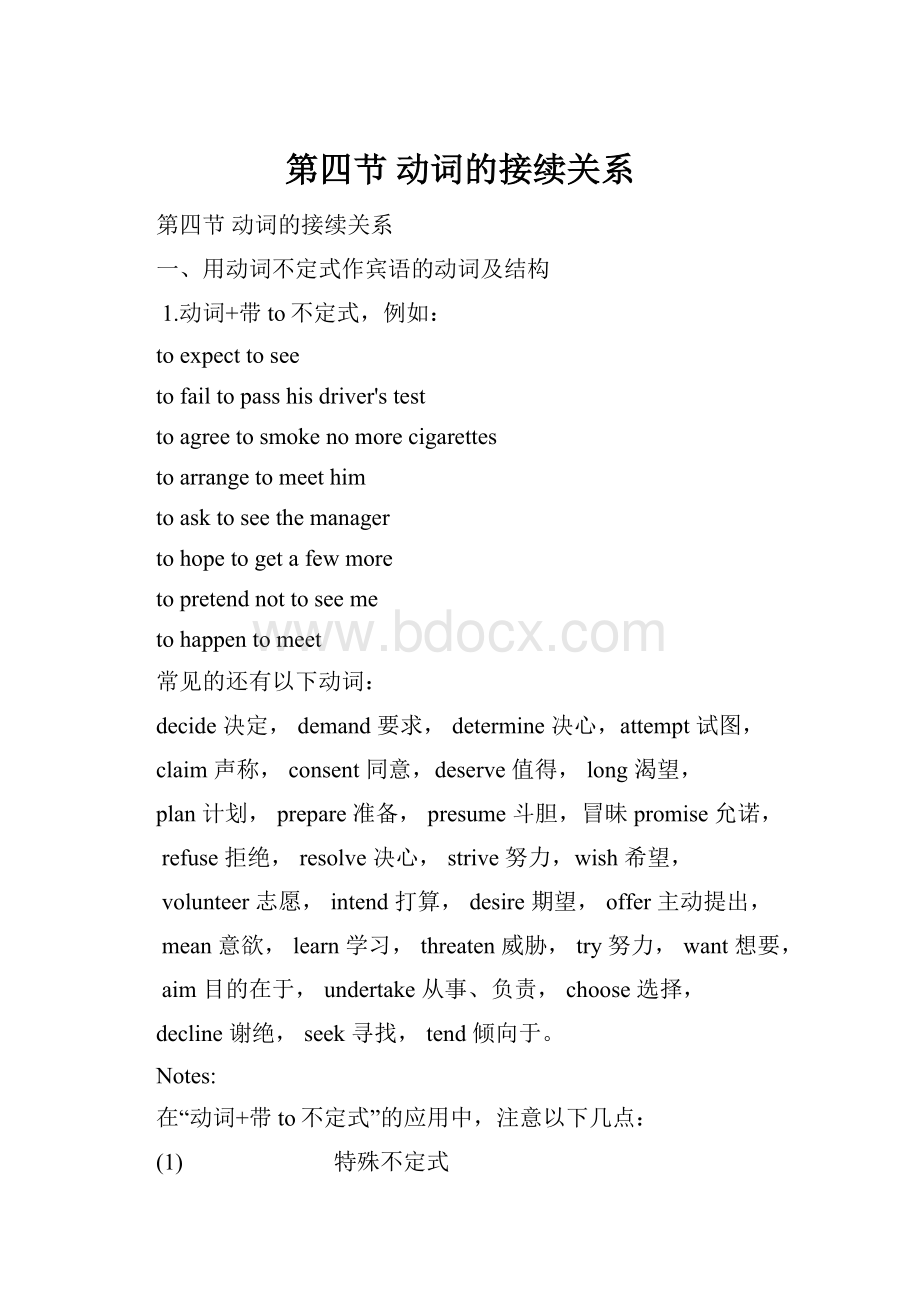第四节 动词的接续关系.docx
《第四节 动词的接续关系.docx》由会员分享,可在线阅读,更多相关《第四节 动词的接续关系.docx(19页珍藏版)》请在冰豆网上搜索。

第四节动词的接续关系
第四节动词的接续关系
一、用动词不定式作宾语的动词及结构
1.动词+带to不定式,例如:
toexpecttosee
tofailtopasshisdriver'stest
toagreetosmokenomorecigarettes
toarrangetomeethim
toasktoseethemanager
tohopetogetafewmore
topretendnottoseeme
tohappentomeet
常见的还有以下动词:
decide决定,demand要求,determine决心,attempt试图,
claim声称,consent同意,deserve值得,long渴望,
plan计划,prepare准备,presume斗胆,冒昧promise允诺,
refuse拒绝,resolve决心,strive努力,wish希望,
volunteer志愿,intend打算,desire期望,offer主动提出,
mean意欲,learn学习,threaten威胁,try努力,want想要,
aim目的在于,undertake从事、负责,choose选择,
decline谢绝,seek寻找,tend倾向于。
Notes:
在“动词+带to不定式”的应用中,注意以下几点:
(1) 特殊不定式
特殊不定式由疑问词+带to不定式构成
疑问词是what,where,who(m),when,how,whether,which,why等。
是否一定要加疑问词,要看情况。
例如:
toknowhowtogetthere
todecidewhethertosellitornot
tofindoutwhattodonext
可以跟疑问词+带to不定式的动词,还有:
forget,inquire,learn,see,settle,think,understand,wonder等。
(2)如果作宾语用的不定式所表示的动作早于主要动词的动作,
不定式要用完成式。
例如:
Theyclaimedtohaveuncoveredafraudlastmonth.他们声称在
上月查明了一宗诈骗案。
Iregrettohavebeenthecauseofallthistrouble.我很抱歉引起了
这么多麻烦。
(3)afford通常和can(或can't)连用。
例如:
Theycan(can't)affordtopayforit.
Wecanhardlyaffordtofirethoseengineers.
(4)如果作宾语用的不定式结构后面有自己的补足语,就得用it作先行词的形式宾语。
例如:
Ithoughtitwrongnottotellhim.
Wefounditimpossibletoanswerallthequestionswithinthetimegiven.
2.若干结构+不带to不定式。
例如:
Youhadbetterhavealookatthispicture.
Iwouldrathernotwait.
常用的结构有:
wouldrather宁愿,hadrather宁愿,
wouldsooner宁愿,ratherthan而不是,hadbetter最好还是,
may(just)aswell还是……的好.
另外,在let,make,have后跟不带to不定式。
例如:
Lettherebenomistakeaboutthis.
I’llhaveXiaoWangrepairtheradioforyou.
(Duringthelunchhehaduslaughingallthetime.)
(I’llhaveyourmotorrepairedrightaway.)
在help后,不定式作宾语可带to,也可不带。
例如:
CanIhelp(to)carryitforyou?
Ihelphim(to)mendhisbicycle.
Detergenthelpstowashclothes.
3.少数介词+一般不定式
一般动词不定式通常不作介词宾语,但下列介词用在含否定意义
的句子中,其后可跟不定式(注意带to和不带to的情况)。
(1) 介词except有两种情况,若该介词前有do,后跟的不定式不带to,
其他情况带to。
例如:
Thechilddidnothingexceptweep.
Hewilldoanythingforyouexceptlendyoumoney.下述句子中
跟to不定式
Heseldomcomesexcepttolookatmypictures.
Thereisnothingtobedoneexcepttoreturn.
(2) 介词besides,than,save(均作“除……之外”解)后常常跟不带to的不定式。
例如:
Theydidnothingelsethanlaugh.
Whathadshedoneforherfathersaveleavehimatthefirst
opportunity?
IhardlyrememberwhatIdidbesidesread.
(3)当but用作except解时,可跟带to不定式。
例如:
Theyhad
nowayoutbuttosurrender.
Shehadnochoicebuttoswallowtheletter.
但是,在“donothingbut”,“cannotbut”和“cannothelpbut”
(三者意为“不得不”)短语后,跟不带to的不定式。
例如:
Theycoulddonothingbutwaitforthedoctorstoarrive.
Shecouldnotbutadmitthattheywerejustifiedinthis.
Thatcannothelpbuthaveanimpactonhisidea.
注意:
“cannothelpbut+不带to不定式”与“cannothelp+doing动名词”
相区别。
后者作“不禁……”解。
Seeingthathisfatherisabouttodie,hecannothelpcryingsadly.
二、只能用动名词作宾语的动词及短语动词,例如:
toavoidovertaking
toconsiderchangingthejob
tokeepwaitingforsb.
toenjoyplayingfootball
todelaysendingthebookover
tofinishreadingit
tosuggestgoingbybus
togiveupsmoking
这样的动词和双词动词有:
miss(错过),admit(to),avoid,
acknowledge,consider,appreciate(赞赏),delay(耽搁),
dislike,enjoy,escape,deny(否认),fancy(爱好),favor(偏爱),
finish,mind,postpone(延期),quit(放弃),recall(回忆),
evade(避开),practise,excuse,imagine,include,keep,report,
resent(怨恨),resist(忍住),stop,suggest,risk,resume(恢复),
facilitate,detest(痛恨),involve,justify,permit,prevent,
putoff,cannotstand,can’thelp,giveup,objectto,feellike,
lookforwardto,persistin,insiston,dependon,approveof(同意),
thinkabout,thinkof,refrainfrom(忍住)。
在用动名词作宾语时,注意以下两点:
(1) 上述动词中的大多数都可根据需要,在其动词的宾语前增添或去掉逻辑主语。
例如:
Shedeniedherhusband(’s)breakingtheagreement.
Thechairmanpostponedmy(me)draftingtheplan.
Weremembertheir\themonceofferingtohelpuswheneverwewereintrouble.
Our\LaoWang’sofferingtotakepartinthegameswashighly
praised.
(2) 在need,require,want,deserve后通常跟动名词主动形式,
但表被动含义,或被动的不定式形式。
例如:
Thedoorneedsoiling(或tobeoiled).
Theroomwantscleaning(或tobecleaned).
Hisletterrequiresanswering(或tobeanswered)immediately.
三、既可用不定式,也可用动名词作宾语的动词
1.用不定式和动名词作宾语,含义基本相同的动词有:
begin,start,cease,continue,cannotbear,hate,like,love,prefer,
propose。
例如:
tobeginwriting(或towrite)
tostartreading(或toread)
topreferwatching(或towatch)television
toloveplaying(或toplay)football
对上述动词的应用注意以下三点:
(1) 在like,hate,prefer等表情感的动词后面,如果表示一般倾向,多用动名词作宾语,如果指具体某次行动,用不定式更多。
例如:
Ihatespeakingbeforeabigaudience.(表示一般倾向)
Ihatetosayso,butreallyIcan’tgo.(表示具体的某次)
Ilikereadingbooks.(表示一般倾向)
I'dliketoreadthatbook.(具体某次)
(2)当谓语动词用进行时时,用不定式作宾语。
例如:
Iamstartingtoworkonmyessaynextweek.
(3)在attempt,intend,plan等动词后用不定式较普遍。
例如:
toattempttodo(少用doing)itbyyourself
tointendtopay(少用paying)thebillthismonth
toplantotake(少用taking)aholidayabroad
2.用不定式作宾语与用动名词作宾语,含义有差别的几个动词:
(1)动词remember,forget,regret的后面,若用不定式作宾语,不定式所表示的动作发生在上述谓语动词之后,若用动名词作
宾语,动名词所表示的动作发生在上述谓语动词之前。
例如:
“remember+不定式”表示“记住要去做某一件事”
“remember+动名词或不定式的完成形式表示“记起过去做过的一件事”。
Youmustremembertowriteuswhenyougetthere.到那里时记住给
我们写信。
Doyourememberwritingherlastmonth?
(=Doyourememberhavingwrittenherlastmonth?
)
你还记得上个月给她写信的事吗?
Pleaseremembertotellhimaboutit.请记住告诉他这件事。
Iremembertellingyouaboutit.这事我记得和你谈过。
“forget+不定式”表示“忘记要做某件事”。
“forget+动名词”表示
“忘记过去做过的一件事”。
Don'tforgettomeethimwhenyougetthere.别忘了到了那里去
见见他。
Ishallneverforgetmeetinghimduringhisinspectionofour
factory.我永不会忘记,在他视察我们厂时,我见到了他。
“regret+不定式”表示“对尚未做,或正在做的事情的遗憾”
“regret+动名词”表示“对过去做过的事情的后悔”。
Weregrettotellyouthatyoucan’tstayhereanylonger.
我们遗憾地通知你,你不能再在这儿多呆了。
Theyregrettedorderingthesebooksfromabroad.
向国外订购了这些书,他们很后悔。
(2) 在动词try,cannothelp,mean,stop,goon后,
用不定式作宾语(在stop后是状语),还是用动名词作宾语,
其含义有明显的差别。
例如:
“try+不定式”表示“努力去做某事”。
“try+动名词”表示“尝试做某事”。
Hetriedtowritebetter.他尽量写好。
Hetriedwritingwithabrush.他试着用毛笔写。
“cannothelp+不定式”表示“不能帮助做某事”。
“cannothelp+V+ing”表示“禁不住,不能不做某事”。
Icouldn'thelptofinishit.我不能帮助结束那件事。
Icouldn'thelpfinishingit.我不得不结束那件事。
“mean+不定式”表示“打算,想要”
“mean+动名词”表示“意味着,意思是”
Idon'tmeantosayweareperfect.我不是说我们已十全十美了。
Revolutionmeansliberatingtheproductiveforces.革命就是为
了解放生产力。
“stop+不定式”表示“停止原来做的事,开始做另外一件事”
(这时不定式是目的状语)。
“stop+动名词”表示“停止做某事”。
HestoppedtospeaktoMartin.他停下来和马丁讲话。
HestoppedspeakingtoMartin.他停止了和马丁的谈话。
“goon+不定式”表示“放下原来做的,改做另一件事”。
“goon+V+ing”表示“继续做一直在做的事”。
Hewentonpointingoutmistakesinthepaper.他继续指出论文中的错误(指同一动作的继续)。
Hewelcomedthenewstudentsandthenwentontoexplainthecollegeregulations.他对新生表示欢迎,接下去就解释学院的规章制度了。
四、用不定式作宾语补语的动词(注意不定式带to或不带to的情况)
1.表“感觉”的动词lookat,perceive,note,leave(听任),listento,see,hear,watch,notice,observe,feel,bid(命令,吩咐)等和三个表“致使”的动词make,have,let后跟不带to的不定式作宾补。
例如:
toseesb.goout
tohearsb.sing
tonoticesb.comeintotheclassroom
tomakesb.laugh
tohavesb.explainit
toletsb.goout
2.表“致使”的其他动词advise,get,cause,allow,drive,encourage,expect,force,intend,invite,permit,tell,trust,urge,persuade,remind,teach,want,warn,get,ask,forbid(禁止),beg,require,tempt(诱使),enable,lead,instruct等,以及表“情感状态”的动词love,like,prefer,hate等后跟带to的不定式做宾补。
例如:
towantsb.toworktogetherwiththem
toexpectsb.tosucceedintheexam
toadvisesb.todothat
toallowmetointroducesb.
togetsb.totalk
totellsb.nottowaitanylonger
towarnsb.nottodosth.
toprefersb.tostay
tolovesb.tocomeagain
tohatesb.todothat
3.表“心理状态的动词think,know,believe,discover,feel(=think),imagine,judge,suppose,understand,consider,declare,find(=consider)等后面常跟tobe结构作宾补,上述动词中的consider,declare,find,prove,think后跟的tobe往往可以省去。
例如:
toprovesb.(tobe)wrong
tothinksb.(tobe)agoodstudent
tobelievesb.tobereliable
toimaginesb.tobeabovefifty
todeclaresb.tobeinnocent
tofindsb.(tobe)dishonest
toconsidersb.(tobe)foolish
五、用分词作宾语补足语的动词
1.表“致使”动词+宾语+现在分词。
例如:
tosetsb.thinking
tokeepsb.waiting
togettheclockgoing
tostartsb.coughing
tohavesb.doingsth.
Hesenttheballflying.
tocatchsb.cheating
leavesb.sleeping
2.表“感觉”动词+宾语+现在分词。
例如:
tosmellsomethingburning
towatchsb.swimming
tofindsb.listeningtotherecorder
这样的动词,还有:
see,hear,feel,notice,observe,lookat,listento等。
注意:
从上述可以看出,表“感觉”的动词,既可以用不带to的不定式作宾语补足语,又可以用现在分词作宾语补足语,
但二者有含义上的差别。
现在分词作这些动词的宾语补足语,
表示动作的进行。
Iheardherplayingtheviolin.我听到她在拉小提琴。
以不带to的不定式作这些动词的宾语补足语,表示动作的完成。
例如:
Ididn’tseetheballbreakthewindow.我没有看到球砸坏窗户。
Wesawhimswimacrosstheriver.Thereforeheescapedbeingcapturedbytheenemy.
Wesawhimswimmingacrosstheriver.Latersomeonetold
ushewasdrowned.
六、用名词或“as+名词(或v+ing)”作宾语补足语的动词
1.用名词直接作宾语补足语的动词有:
name(命名),nominate(提名),
call(称呼),choose(选择),elect(选举),define(定义为)。
例如:
WeelectedJohnmonitor.
WecallhimIronOx.
(当然不是说这些动词的后面只能用名词作宾语补足语。
)
2.用as+名词或as+doing作宾补的动词
(1)(把……看成……)regard,see,recognize,thinkof
(2)(把……当成……)treat,take,mistake,
(3)(把……认为是……)consider,lookupon,referto,accept,
acknowledge
(4)(描述为……)describe,depict(描绘),represent,另外,
还有:
declare(宣布),denounce(谴责),employ(使用),
use(利用),show(证明),organize(组织),express(表示),等。
例如:
todescribesb.asateacher
todescribesb.asbeingveryclever
totreatthemashonoredguests
todenouncesb.asatraitor
toseesb.asabasicallykindperson
toacknowledgesb.asanauthority
七、可带两个宾语的动词
一般地说